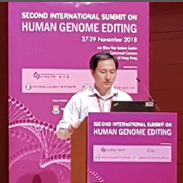
Submitted by Chantal Holland on Tue, 04/12/2018 - 09:44
Did human embryo editing just get platformed?
Ayo Wahlberg
Attending the 2nd International Summit on Human Genome Editing in Hong Kong (27-29 November 2018) was at once surreal, disturbing, fascinating and sobering. Together with the rest of the world, Summit delegates found out on Monday 26th of November through breaking news that the world’s first genetically edited babies, called Lulu and Nana, had apparently been born with their CCR5 genes disabled as a protective measure against HIV. The shock was all the more palpable since the summit had been convened with the express goal of debating and discussing whether human trials with embryo editing were at all relevant at this stage, not least given the many open safety questions that remain concerning unpredictable ‘off-target’ effects, ‘on-target’ complexities, mosaicism as well as challenges around efficiency, specificity and fidelity. The news broke through what looked like an orchestrated campaign featuring an exclusive Associated Press interview with lead scientist Dr. He Jiankui of the Southern University of Science and Technology in Shenzhen, a slick YouTube justification video (“If I didn’t do this, someone else would”) as well as an open access article entitled “Draft Ethical Principles for Therapeutic Assisted Reproductive Technologies” in the CRISPR journal by among others He and co-author Ryan Ferrell of HDMZ, a science and healthcare marketing agency.
Before the story broke, He Jiankui was already on the summit programme as an invited speaker on a panel about Human Embryo Editing. Yet, so massive were the fallout and outcries in the following day that, until He walked through a side door and strode across the stage to the podium in the Ran Ran Shaw auditorium at Hong Kong University on Wednesday 28th of November, conference participants and hundreds of newly accredited media delegates didn’t quite know whether he would in fact show up. Show up he did, ushered in by an audible gasp from an incredulous audience. It was an awkward moment, with so much unknown at that point and with He Jiankui bathed in the frenzied strobe flashes from hundreds of clattering cameras. He began by apologizing that news of Lulu and Nana had been “leaked” before the scientific community had had a chance to scrutinize his work since the paper detailing the embryo editing, implantation and birth of the twin girls was still in review. He then proceeded to give that very paper to a captivated audience.
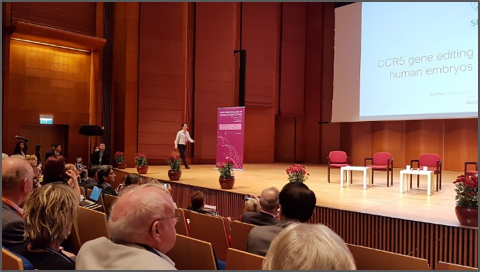
He Jiankui walks in to present his paper on CCR5 gene editing
So much has been written and said about He Jiankui’s human embryo editing work in the days since the story broke and He subsequently emerged to present and defend it at the 2nd international summit on Human Genome Editing. On newspaper front pages, breaking news television, online blogs, radio broadcasts, Weibo, WeChat and the Twittersphere, He Jiankui has been condemned for moving from bench to bedside much too prematurely, accused of violating China’s laws and regulations, reproached for insufficient ethical review of his work, criticised for problematic recruitment and consent practices, reproved for carrying out his research in stealth, censured for not having targeted an ‘unmet medical need’ and questioned about his finances. Others have called for a more “balanced” reaction, suggesting that the time may indeed be right for human trials: “At some point, we have to say we’ve done hundreds of animal studies and we’ve done quite a few human embryo studies”.
The Ministry of Science and Technology in China has announced that He Jiankui is under investigation and has ordered all research institutes to suspend any research projects led by He: “China has banned reproductive use of gene editing in human embryos. The experiment has violated laws and regulations in China”. 120 biomedical scientist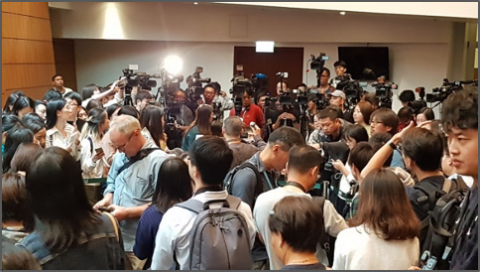 s in China quickly signed a letter calling He’s experiment “crazy” while deploring what they saw as a “huge blow to the global reputation and development of Chinese science, especially in the field of biomedical research”. Likewise, the organizing Committee of the International Summit on Human Genome Editing issued a statement at the close of the summit on the 29th of November in which they condemned He’s work as “deeply disturbing” and “irresponsible” since its “flaws include an inadequate medical indication, a poorly designed study protocol, a failure to meet ethical standards for protecting the welfare of research subjects, and a lack of transparency in the development, review, and conduct of the clinical procedures”. Still others have pointed out that global science has its share of the blame for cultivating a culture that rewards sensational “firsts”.
s in China quickly signed a letter calling He’s experiment “crazy” while deploring what they saw as a “huge blow to the global reputation and development of Chinese science, especially in the field of biomedical research”. Likewise, the organizing Committee of the International Summit on Human Genome Editing issued a statement at the close of the summit on the 29th of November in which they condemned He’s work as “deeply disturbing” and “irresponsible” since its “flaws include an inadequate medical indication, a poorly designed study protocol, a failure to meet ethical standards for protecting the welfare of research subjects, and a lack of transparency in the development, review, and conduct of the clinical procedures”. Still others have pointed out that global science has its share of the blame for cultivating a culture that rewards sensational “firsts”.
For now, we must await the results of the Ministry’s investigation as well as scientific peer review of He Jiankui’s data. But most of all, we must remember that it is the seven couples who participated in He’s clinical application of human embryo editing who need to be given all the follow-up support they might require as a matter of urgency, with a particular emphasis on the welfare of Lulu, Nana and their parents (not to mention an apparent second pregnancy). Inclusion criteria for He’s study were that the man should be living with HIV and that the couple should be infertile, two conditions which are highly stigmatised and devastating for families in China. The wellbeing of Lulu, Nana and each of these couples – who have wound up at the heart of an international scientific scandal – should be the priority of authorities in China as well as the international community.
The dawn of human embryo editing?
Notwithstanding the sensational He scandal, the 2nd international summit on Human Genome Editing may well come to be remembered as the moment where human embryo editing was platformed. At least preliminarily so. In his plenary talk to open the day on November 28th, Dean of the Harvard Medical School, George Daley recounted how rapidly the conclusions of influential committee reports on Human Genome Editing had evolved towards clinical application in the last three years. The closing statement of the 1st International Summit on Human Genome Editing held in 2015 underlined that “it would be irresponsible to proceed with any clinical use of germline editing unless and until", closely followed by a May 2016 report from the International Society for Stem Cell Research which stated that "any attempt to modify the nuclear genome of human embryos for the purpose of human reproduction is premature and should be prohibited at this time". However, following advances in the science of germline editing only some months later, in February 2017, the US National Academies of Science concluded in a report that “germline editing [clinical] research trials might be permitted, but only after much more research". A year later in July of 2018, the Nuffield Council on Bioethics went even further when they concluded that "we can, indeed, envisage circumstances in which heritable genome editing interventions should be permitted". These changes in language, Daley suggested, indicated that there was a growing consensus among scientists in the field of genome editing that the science of germline editing was approaching its translational moment.
To be sure, the triumphant inevitability or path dependency which informed Daley’s account has been problematized by many. For example, in an op-ed published on the 29th of November in the Washington Post, Benjamin Hurlbut, Sheila Jasanoff and Krishanu Saha argued that “we need more than a moratorium that controls when germline editing moves into reproductive medicine, but a process of genuine deliberation on whether it should move in this direction”. Moreover, many countries continue to expressly prohibit the implantation of gene edited embryos, including China and Germany. Nevertheless, it is perhaps not so surprising – even amidst the media frenzy surrounding He Jiankui’s clinical human embryo editing experiments – that organizing committee members in Hong Kong proposed, in their final statement on the 29th of November, that “it is time to define a rigorous, responsible translational pathway toward [clinical] trials… Such a pathway will require establishing standards for preclinical evidence and accuracy of gene modification, assessment of competency for practitioners of clinical trials, enforceable standards of professional behaviour, and strong partnerships with patients and patient advocacy groups”. What is more, on that same day, the MIT Technology Review reported that the Stem Cell Institute at Harvard University was planning to use CRISPR to edit sperm cells “to show whether it is possible to create IVF babies with a greatly reduced risk of Alzheimer’s disease later in life”.
A bit of a Twitter novice I’m not very good at live-tweeting from conferences. However, while listening to and watching He Jiankui’s infamous presentation at the Hong Kong summit on the 28th of November there was one slide in particular that caught my attention which I promptly (along with many others) sent out into the #GeneEditSummit Twittersphere tagged with the short comment “here it is”. In hindsight I believe whatI meant by “it” was the outline of a possible human embryo editing platform. For, whathuman embryo editing does is fuse two 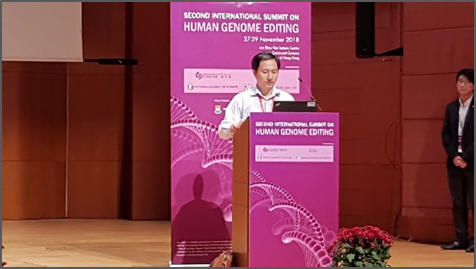 biomedical platforms (Keating & Cambrosio 2000), namely what Sarah Franklin (2013) has called “the IVF platform” and the Whole Genome Sequencing platform. For Keating & Cambrosio, a biomedical platform “is less a thing than a way of arranging things in both a material and a discursive sense. In both senses (as an instrument or a project), the platform is the basis for the organization of activities”. It is in this sense that He’s slide outlines one possible form that a Human Embryo Editing (HEE) or Human Germline Editing (HGE) platform might look like. In the slide, HGE appears as a total reproductive platform bringing together the techniques of ‘carrier’ testing, IVF/ICSI, CRISPR/Cas9-gRNA, PGD, NIPT and cord blood banking with the objective of selectively editing and implanting human embryos. I am not suggesting that an HGE platform has now stabilised, after all as things stand, it is only He Jiankui and the clinicians and scientists he has worked with who have actually applied HGE clinically (and even this case has yet to be independently verified). Instead what I am suggesting is that the development of a “rigorous, responsible translational pathway” will exactly entail refining and defining the particulars of a HGE platform – a way of arranging things materially and discursively – as it continues to fuse IVF, CRISPR/Cas9-gRNA, PGD, NIPT and WGS.
biomedical platforms (Keating & Cambrosio 2000), namely what Sarah Franklin (2013) has called “the IVF platform” and the Whole Genome Sequencing platform. For Keating & Cambrosio, a biomedical platform “is less a thing than a way of arranging things in both a material and a discursive sense. In both senses (as an instrument or a project), the platform is the basis for the organization of activities”. It is in this sense that He’s slide outlines one possible form that a Human Embryo Editing (HEE) or Human Germline Editing (HGE) platform might look like. In the slide, HGE appears as a total reproductive platform bringing together the techniques of ‘carrier’ testing, IVF/ICSI, CRISPR/Cas9-gRNA, PGD, NIPT and cord blood banking with the objective of selectively editing and implanting human embryos. I am not suggesting that an HGE platform has now stabilised, after all as things stand, it is only He Jiankui and the clinicians and scientists he has worked with who have actually applied HGE clinically (and even this case has yet to be independently verified). Instead what I am suggesting is that the development of a “rigorous, responsible translational pathway” will exactly entail refining and defining the particulars of a HGE platform – a way of arranging things materially and discursively – as it continues to fuse IVF, CRISPR/Cas9-gRNA, PGD, NIPT and WGS.
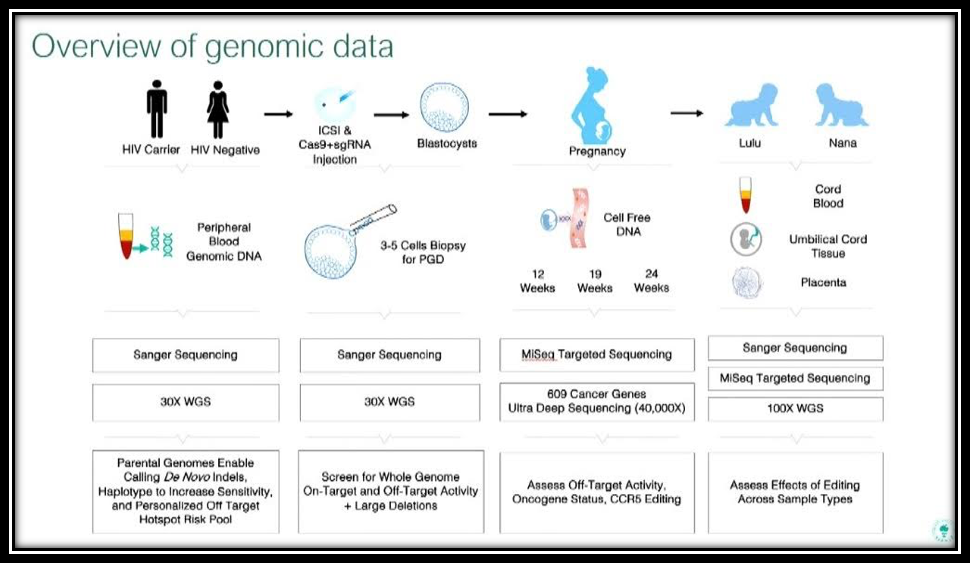
An HGE platform? He Jiankui’s slide explaining the process behind the birth of Lulu and Nana.
Selective reproduction in a post #CRISPRbabies world?
In 2014, my colleague Tine Gammeltoft and I defined selective reproductive technologies (SRTs) as “laboratory and clinical techniques developed for the selective fertilization of gametes, implantation of embryos, or abortion of fetuses in order to prevent or allow the birth of certain kinds of children” (Gammeltoft & Wahlberg 2014). It seems that with the birth of Lulu and Nana, we may yet have to add “the selective editing of gametes and embryos” to our definition. One day, HGE may join carrier testing, PGD and prenatal screening/testing as yet another means for couples to selectively form their families.
We are of course not by any means there yet and it is not clear whether the promises and expectations that surround HGE will ever materialise. And, as already pointed out, there are many critics who continue to question whether the clinical application of HGE should ever be permitted. If Hong Kong’s 2nd International Summit on Human Genome Editing is anything to go by, then a global scientific scandal is not enough to put off substantial ongoing efforts to move germline genome editing into the clinic. At the same time, as many summit participants pointed out, one of the biggest challenges facing a translated HGE (if it ever does materialise and stabilise as a platform) is that of access and equity. If anything, HGE will be even more expensive than IVF and PGD, both of which are already so prohibitively expensive. It is hard to see how an HGE platform could be made mobile and affordable anytime soon. Whatever the next steps for HGE, let us never forget Lulu, Nana, her parents as well as the six other couples who made global headlines in Hong Kong last week.
